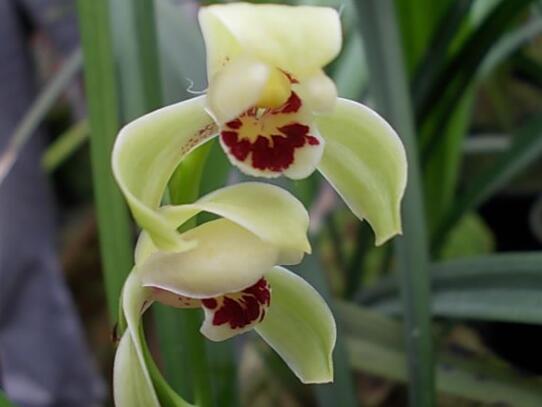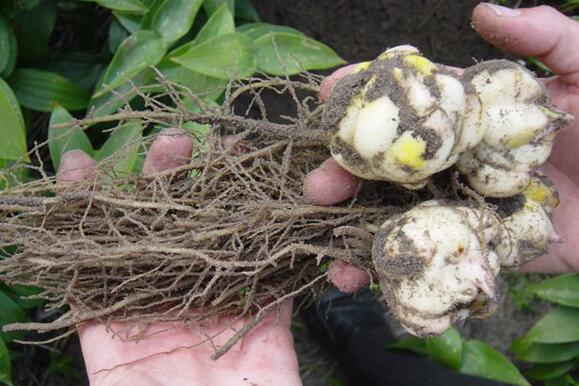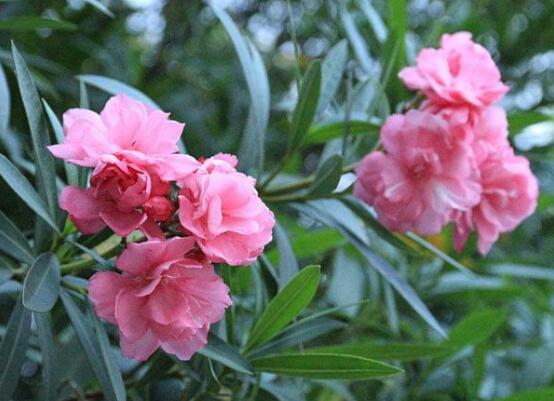Is Jian Lan easy to reproduce? the propagation method / ramet reproduction survival rate of Jian Lan is high.
Jianlan is not only a common plant in people's life, but also a variety that many plants love to raise at home, which is generally used as decorative flowers. And because this plant is so popular, many people want to raise one at home. Is it easy for Jianlan to breed? In fact, it is very easy to reproduce if you have mastered the method. There are some breeding methods of Jian Lan below, which you can refer to.

Is Jiandan easy to breed / find the right way to breed easily
On the question of whether Jianlan is easy to breed, it actually depends on whether you know the method, if you master the most method is still very simple. The commonly used reproduction method of Jianlan is plant propagation. The specific methods of this propagation method and the points that need to be paid attention to are explained in detail below. Let's move on.
2. Propagation methods / ramet propagation of Cymbidium
1. Ramet time
Among the propagation methods of Jian Lan, ramet propagation is the most common one. Generally, when selecting ramet propagation for Jian orchid, it is best to be in the spring and autumn seasons, which are most conducive to the growth of Jian orchid. And Jian Lan can be propagated once every three years.
two。 Plant selection
Plant selection is an important link in the breeding process of Jian Orchid. When selecting plants, you must choose plants with strong growth and dense pseudocorms, because the survival rate will be higher, on the contrary, the survival rate will not be too high. Keep that in mind.
3. Reproduction method
First of all, some broken tiles should be padded on the holes of the basin, then covered with coarse stones, and then some coarse granular soil and a small amount of fine soil should be put on it. Finally, the selected soil should be put into the basin for planting. Finally, it is important to keep at least 5 connected pseudocorms in each clump after ramification.
4. Watering method
It is best to water less before ramet, and water thoroughly at one time after successful ramet. Remember to move the ramets to a cool place for 10-15 days after watering. During this period, the soil must be kept moist and watered in time for dry and solid phenomena. After this period of time, the amount of water can be reduced and maintained normally.
The family culture method of Cymbidium the breeding method of Cymbidium
Cymbidium is a Luzhou-scented flower, which is a potted plant with excellent ornamental value at home, and many people will raise it. So we still need to know about Mulan in many aspects. So, how do you breed Melan? How do you reproduce? Next, I would like to introduce to you the relevant knowledge about the breeding and reproduction of Cymbidium.
The method of Family Culture of Melilan
1. The matured bark, peat soil and rotten leaf soil are commonly used in potted Magnolia substrate. Pay attention to cleanliness in watering and avoid direct spraying with tap water. Water once a day in midsummer and once every 4-5 days in winter. The room temperature should not be too high, otherwise it is easy to get sick in spring. Fertilization is applied once a month during the growing period to prevent drought in autumn and the basin soil should not be too wet in winter. From August to September, the larger clumps of Cymbidium were pulled out of the pot and divided into 3-4 tubes.
2. After buying bare root Magnolia seedlings, first soak them in clear water to make the dried fleshy roots full without wrinkles, then wash the roots, cut off the rotten roots, and dry them until the roots are white and softer, then they can be planted on decaying leaves with waste from the culture substrate of ink orchid or edible fungi or coal furnace ash. The basin soil can also be dug under the trees or between the rocks on the mountain, and then mixed with the river sand to facilitate air and water permeability and ensure that it is not hardened. The cultivation needs to be sterilized, and it can be exposed to the sun for three or four days, or it can be sterilized by heat in a pot. Avoid deep planting when putting on the basin, and it is appropriate to use the false bulb to expose the soil surface 2 to 3. Do not water the orchid immediately after planting, put it in the shade for two days and then water thoroughly, about 10 plants per pot.
3. "Qi" is the root of the orchid's life, and it should be ventilated both above ground and underground. Cover the bottom of the basin with a layer of charcoal or sand 3 cm thick. Keep the basin soil loose, do not water too much, spray more foliar water and surface water to increase air humidity. Pay attention to shade from May to October, not in direct sunlight, but in the morning light. Especially in the period of flower bud differentiation, that is, six or seven months before flowering, a windowsill or balcony should be placed to receive sunlight to promote flower bud differentiation. After the new leaves of Cymbidium were grown, the thin liquid fertilizer mainly composed of phosphorus and potassium was applied once a month, and once more after the flowers were withered. Remember: the leaves of ink orchid are yellow and thin because of lack of fat. The leaves are black and green and the scorched leaf tips are too fat.
Propagation method of Cymbidium
(1) ramet propagation.
This method is simple and reliable, blossoms quickly after ramet, and can preserve the original characteristics of the variety. It is a method of reproduction by dividing the pseudobulbs of tufted orchids into single or 2-3 groups and planting them independently in order to achieve the purpose of proliferation. The ramet propagation of orchids is best carried out in the dormant period, that is, the dormancy period before the new buds are unearthed, before the new roots grow, or after flowering. Separate orchid plants should be viewed, cut off rotten roots and withered leaves. In the method of disinfection, the 10~15min of the root of orchid plant can be soaked in 70% methyl topiramate 800mm 1000 times solution, and then it can be replanted after soaking and drying slightly.
Although ramet propagation is simple and easy, and can maintain the inherent characteristics of varieties, so that many valuable varieties can be preserved, but after all, the ramet reproduction coefficient is small, it is difficult to meet the needs of large-scale production and market. Therefore, we must explore more scientific and advanced methods of reproduction. The tissue culture propagation of orchids is a more advanced propagation method which can meet the needs of production and market.
(2) tissue culture.
Tissue culture is an advanced science and technology developed on the basis of cell theory and plant cell totipotency theory. At present, it is constantly popularized in the field of forest reproduction. According to the analysis of relevant statistical data, the tissue culture propagation of herbaceous plants is easier and the success rate is higher than that of woody plants. The propagation of orchid tissue culture is an advanced method of orchid propagation using advanced equipment and modern science and technology.
The orchids cultured in tissue culture have strong resistance, few diseases and insect pests, high survival rate, and can be mass produced. In the past 20 years, some domestic scientific research institutions, such as the Chinese Academy of Sciences, Beijing, Kunming, South China Botanical Research Institute, Shanghai Garden Institute, Sichuan Academy of Agricultural Sciences and so on, have carried out this work and made varying degrees of progress. The meristematic asexual seedlings of Chunlan, Jianlan and Mulan were obtained. Tropical orchid has a large scale in automatic control, industrial production, tissue culture and rapid propagation and new variety breeding in Taiwan.
The above is for you to introduce the relevant knowledge about the breeding and reproduction of Cymbidium, is it clear to everyone? Please pay attention to more household knowledge.
September! The most suitable month for flower breeding, sowing, cutting, grafting, ramet, striping should try ~ September! The month most suitable for flower breeding, sowing, cutting, grafting, ramet, and striping should be tried.
September is coming, which is a very lovely month. For flower friends, this is neither hot nor cold, which is very suitable for the season of flower growth, and it is also a good time for sowing, cutting, grafting, splitting and striping. Let's move along with Huahua!
Sowing seeds
The flowers that can be sown in autumn are: hollyhock, carnation, high snow wheel, dwarf snow wheel, pansy, goldfish grass, petunia, daisy, Yu beauty, calendula, black chrysanthemum, iris, beautiful cherry and so on.
In addition, greenhouse flowers such as cyclamen, primroses, golden lotus, melon and leaf chrysanthemum, four seasons begonia, Fulang flower, bao flower, can also be sown at this time, but to spend the winter in a plastic shed.
Huahua takes Petunia as an example. The specific operation methods are as follows:
1. After the peat soil, rotten leaf soil and perlite are fully mixed at 1:1:1, pour them into the seedling basin and compact them slightly.
2. Carbendazim was mixed with water 800 times to make carbendazim solution. The carbendazim solution first watered the soil in the seedling basin, and then poured water into the seedling box outside. Soak the seedling basin for one day and one night. After soaking, the soil was hung for 2-3 hours.
3. The suitable temperature for sowing is about 20-25 degrees. The basin soil should be watered once before sowing to ensure that carbendazim does not harm the seeds. Petunia seeds are very small, you can use spoons or toothpicks (water) scoop (dip) to take a seed on the soil, pay attention to a basin to put one on it!
4. Some clear water is injected into the bottom of the large seedling box, and the water level reaches about half a centimeter at the bottom of the small seedling basin.
5. Just put the lid or film on the astigmatism ventilated place. If there is no water, add water, wait 7-10 days, and then gradually see the sun.
Cuttage
The woody flowers that can be cultivated by cutting in autumn are: purple magnolia, Spiraea, pomegranate, hibiscus, crape myrtle, eight immortal flowers, figs, oleander, June snow, gardenia, star anise gold plate, peony, peony and so on.
Can also cut some grass flowers, such as a string of red, thousand-day red, marigold and so on.
Take hydrangea as an example, the specific operation methods are as follows:
1. Prepare materials.
Choose healthy and relatively strong branches. The medium can use fine vermiculite, fine seedling peat and so on. Try to use art knives and the like, do not cut with scissors, because scissors cut the wound is squeezed, and the knife cut is not the same.
2. Oblique cut about one inch below the node, which is only 35 centimeters.
3. Cut flat above the node to keep the bud.
4. Cut off the leaves by about 2/3 or 1/2. According to the size of the leaves, leave less for the big ones and more for the small ones.
5. Before cutting, the potted soil should be sterilized with potassium permanganate or carbendazim. Then the medium is thoroughly watered and filled with water. Insert the cuttings into the basin soil and insert all the parts below the nodes. Finally, put the basin into a tray filled with water and spray water frequently to moisturize it. (remember, don't put it in the sun.)
6. The current temperature takes about 20 days to take root, and it can be pulled out and put on the basin after a month.
Grafting
The flowers and trees that can be grafted in autumn are: peony with peony root as rootstock, peony with excellent varieties, cactus as rootstock, fine crab claw orchid, keel as rootstock, tiger thorn plum and so on.
Huahua rootstock is the same year peach seedling, and the scion is green plum branch as an example, the specific operation methods are as follows:
The main results are as follows: 1. The female parent should choose plants with blooming flowers and strong trees, and cut the buds with full growth and good growth.
2. The method of taking buds with three knives, draw and cut a shield about one centimeter around the selected bud, the lower part is slightly longer than the upper part.
3. Peel off the buds from the outside to the inside with your fingernails. After taking out the buds, you can put them in water to prevent water loss.
4. Draw the T-shape with a knife at the base of the rootstock 10 to 15 centimeters smooth, slightly longer than the bud, and use the back of the knife or fingernail to cut open the cortex.
5. Insert the bud and wrap it with plastic sheet.
Pressing strip
The species of ornamental flowers and trees that can be cultivated by pressing are: Begonia, brocade, eight immortals, gardenia, oleander, spring welcome, Admiralty, sweet-scented osmanthus, purple magnolia, jasmine, Michelia, camellia, pearl orchid, French holly, snowball, Qionghua, snowspray, Spiraea and so on.
Taking Gardenia jasminoides as an example, the operation method is as follows:
1. Choose the branches you like, which can be extra parts that need to be cut off, or twists and turns that are healthy and growing well.
2. Carve a ring of bark on the branch with a sharp knife, then peel off the bark. The width is 1-2 cm.
3. Make a funnel with a beverage bottle, cut it in the middle, put it on the ring and tie it with wire.
4. Put water-retaining materials such as culture soil into the beverage bottle and wrap them up and down with transparent film to avoid water leakage and soil exposure as far as possible. After a few days to replenish some water, maintain humidity, wait patiently, generally 2-3 months can take root.
5. After the root system is developed, the branches can be cut and planted directly. 6. The high pressure is successful, cut off and put on the basin.
The advantages of high-altitude striping propagation over cutting propagation are as follows: 1 thicker branches can be propagated directly. 2 the insurance coefficient is high, even if it does not take root successfully, the branch will not die.
Ramet
The plants that can be used for autumn ramet are: Cymbidium, Cymbidium, Jian Orchid, Paeonia lactiflora, Peony, Guangdong evergreen Chrysanthemum, Tiger tail Orchid, Little Angel, Kidney Fern, Phyllostachys pubescens, one-leaf Orchid and so on.
In addition, hyacinths, tulips, freesia, calla lilies, Lycoris radiata and so on can also be planted at this time.
Huahua takes plain sailing as an example, the specific operation methods are as follows:
1. Plain sailing, which has been raised for two years, has been very strong, and there are so many trees that a pot is almost out of place. At this time, ramets can be used to solve the problem.
2. Reverse buckle. If it is not easy to take out, you can pour some water first, and then use your thumb to top the drain hole under the flowerpot, and then you can take the soil out of the whole basin.
2. Separate the cultivated soil from the root system, do not harm the root system, especially the small root system.
3, need to divide into several pots, try to choose a basin with strong plants and young plants, in order to improve the survival rate.
4. Put the culture soil in the flowerpot and plant it smoothly after the ramet. Don't shine directly in the sun for the first few days, and when the root system recovers, you can let the flowers enjoy the sun.
Babies, if you have any other great experience about breeding in September, please submit your contribution or leave a message to Huahua.
- Prev

How to reproduce lilies? the four propagation methods / sowing and reproduction of lilies have a high survival rate.
Lily, one of the famous flowers in China, has beautiful shape, elegant posture and rich colors. It is potted at home by many flower friends. But is a pot of lilies too monotonous? it's time to breed several pots and raise them together. How do lilies reproduce? According to the inquiry, the breeding methods of lilies are sexual and asexual.
- Next

How to propagate oleander, two propagation methods of oleander / high survival rate of cuttage in spring
Oleander, a kind of ornamental plant, although it is poisonous, its beauty and medicinal value are beyond doubt, which is one of the reasons why people grow oleander when they know it is poisonous. Because of the efficacy of oleander, it is imperative to propagate it in large quantities. How to reproduce oleander?
Related
- Fuxing push coffee new agricultural production and marketing class: lack of small-scale processing plants
- Jujube rice field leisure farm deep ploughing Yilan for five years to create a space for organic food and play
- Nongyu Farm-A trial of organic papaya for brave women with advanced technology
- Four points for attention in the prevention and control of diseases and insect pests of edible fungi
- How to add nutrient solution to Edible Fungi
- Is there any good way to control edible fungus mites?
- Open Inoculation Technology of Edible Fungi
- Is there any clever way to use fertilizer for edible fungus in winter?
- What agents are used to kill the pathogens of edible fungi in the mushroom shed?
- Rapid drying of Edible Fungi

